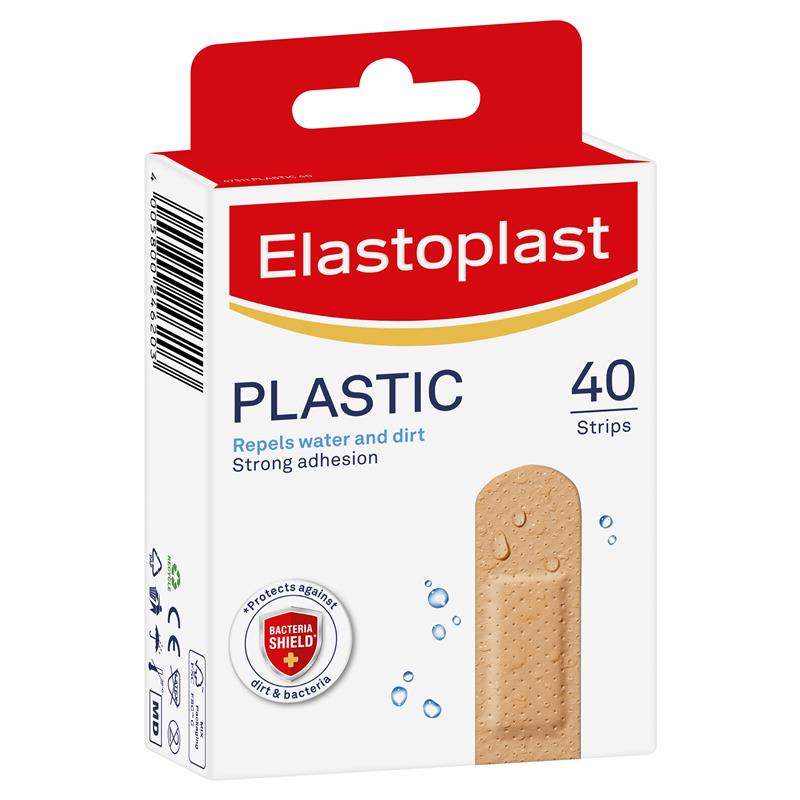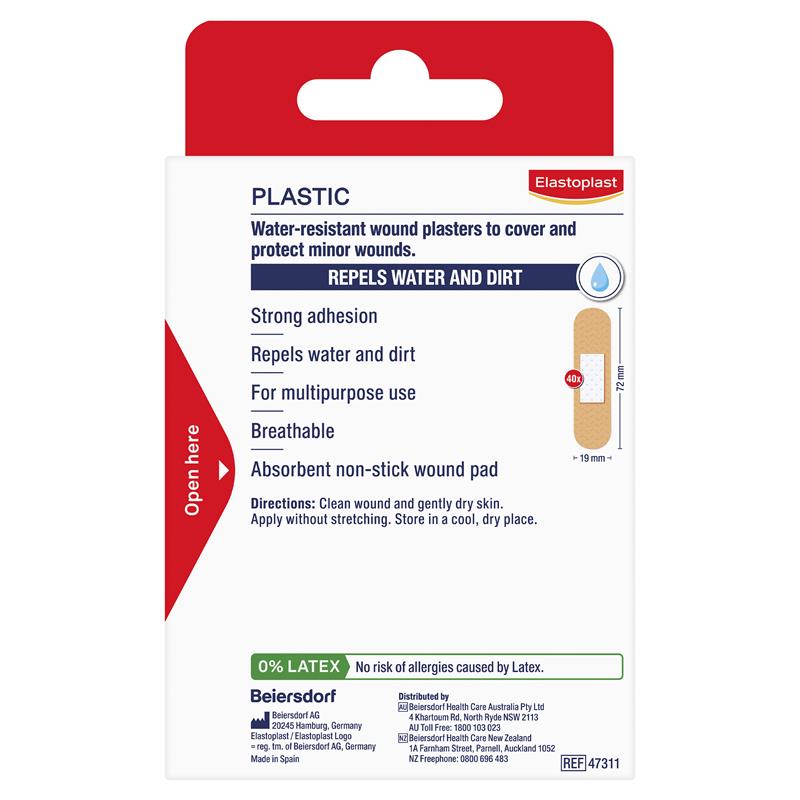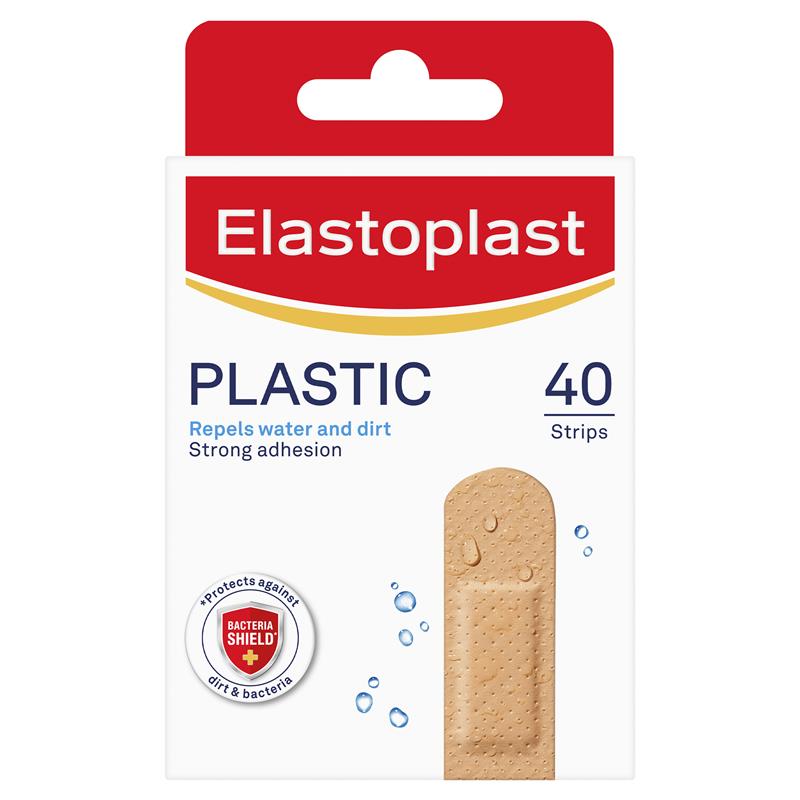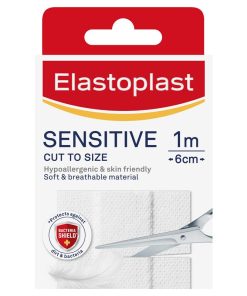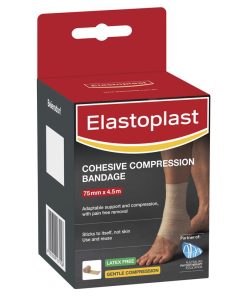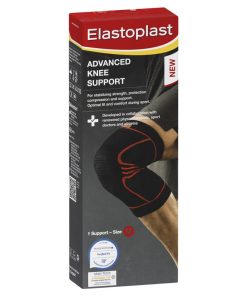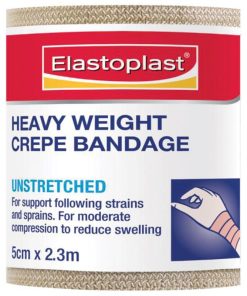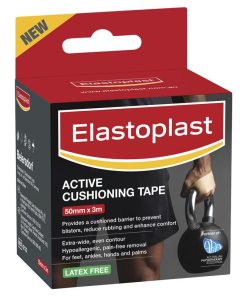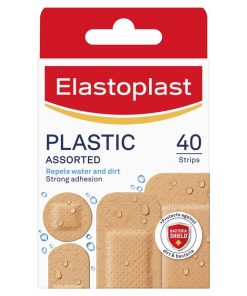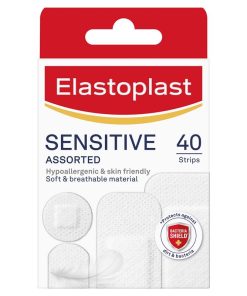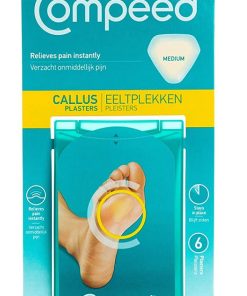Elastoplast Plastic Water-Resistant 40 Plasters Elastoplast
$ 5,95 $ 3,57
Elastoplast Plastic Water-Resistant – water-resistant protection for minor, everyday wounds.
Elastoplast Plastic Water-Resistant Plasters are a traditional plaster, suitable for all purposes. Stays in place with strong adhesion that seals all around the wound, keeping dirt and germs out. The plastic backing is made from a breathable material that is water and dirt repellent – helping these plasters stay in place for longer during day-to-day activities.
FEATURES
- Breathable material
- Strong adhesion
- All-purpose
Each plaster has a non-stick wound pad that cushions the wound while absorbing excess blood and fluid. Available in a variety of different sized strips and shapes that are suitable for all types of smaller wounds.
All-purpose and perfect for the medical cabinet at home.
DIRECTION
Step 1 – Clean the wound and gently wipe away any foreign objects such as dirt or grit.
Step 2 – Dry the skin around the cut or graze very carefully.
Step 3 – Apply plaster without stretching it, to avoid creases.
PACKAGING SIZE
| Product | Size | Quantity |
| Plastic | 19 x 72mm | 20 Strips |
| 20 Strips | ||
| (one strip size) | ||
| Plastic | 19 x 72mm | 40 Strips |
| 40 Strips | ||
| (one strip size) | ||
| Plastic | 19 x 72mm | 20 Strips |
| 40 Assorted Strips | 30 x 72mm | 10 Strips |
| 50 x 72mm | 2 Strips | |
| Ø 23mm | 8 Spots | |
| Plastic Extra Wide | 30 x 72mm | 20 Strips |
| 20 Strips | ||
| (one strip size) |
WARNING
Wear during activities that lead to discomfort. Seek medical advice if in doubt about the injury. Only use on clean, intact skin. The product should be applied as illustrated. Ensure product is not uncomfortably tight and blood flow is not restricted. Avoid wearing for prolonged periods e.g. whilst sleeping. Do not use if you have a known allergy to any of the specified materials. Consult a physician and stop use if a rash develops, pain is prolonged or if conditions worsen.
FREQUENTLY ASKED QUESTIONS
1. How often should I change my plaster?
For hygienic reasons, it is recommended that you change Standard First Aid Dressings daily.
2. Is it better to let small wounds dry at the fresh air instead of putting on a plaster?
It is a commonly held myth about wound care that keeping minor cuts and grazes uncovered helps them to heal faster. The contrary is true! It is proven that covered wounds have a reduced risk of infection and heal more efficiently. Elastoplast plasters are the ultimate addition to your first aid supplies. They provide caring, antibacterial protection until the wounds are completely healed.
3. When should I consult a doctor?
We recommend contacting a medical professional under the following circumstances:
- If the wound is deep and causing major bleeding
- If the wound shows signs of infection such as redness, warmth, pain and swelling
- If there are embedded foreign objects in it
- In the case of animal or human bites
- If the wound is in the area of the face
Of course, whenever you have questions or are uncertain it is advisable to get in contact with a medical professional.
4. What if my wound gets infected, swells, creates pus, or suppurates?
You should contact a medical professional if you recognise any signs of infection. This is not only the occurrence of pus but also swelling, redness, heat, pain, itching or burning. In case of infection the wound will need medical care and special medical treatment.
5. Which plaster should I use for my sensitive skin?
If you have very sensitive skin we recommend using the Elastoplast Sensitive products. These plasters are especially developed for sensitive skin and are very skin friendly and hypoallergenic.
6. Which Elastoplast plaster are waterproof and water resistant?
The Elastoplast Aqua Protect Strips as well as the Heavy Duty Waterproof Fabric range are waterproof and will not go off while washing or showering. All Elastoplast Plastic plasters as well as the Junior plasters are water resistant.
Quick Shipping and Professional Packaging
We provide a variety of shipping options due to our long-running partnerships with UPS, FedEx and DHL. Our warehouse staff will package all goods to our exacting requirements. Your goods are thoroughly checked and secured properly prior to shipping. We ship to thousands clients each day across multiple countries. This shows that we're committed to being the largest online retailer in the world. Both Europe and the USA have distribution and warehouse centres.
Note: Orders that include more than one item will be assigned a processing date depending on the item.
Prior to shipment, we will inspect thoroughly the items you've purchased. The majority of orders are shipped within 48 hours. The expected delivery time will be between 3-7 days.
Returns
We don't control the inventory in our factory and warehouse. This means that the actual stock could change at any time. Be aware that your order may be out of stock when the order has been placed.
Our policy is valid for 30 days. If you have passed 30 days in the past since you purchased and we are unable to offer you a refund or exchange.
The item cannot be used and in its original condition. It must also still be in the original package.
Related products
Bandages, Gauze & Dressings
Elastoplast Crepe Bandage Medium Weight 10cm x 1.6m Elastoplast
Bandages, Gauze & Dressings
Bandages, Gauze & Dressings
Elastoplast Cohesive Compression Bandage 75mm x 4.5m Elastoplast
Braces & Sleeves
Bandages, Gauze & Dressings
Bandages, Gauze & Dressings
Bandages, Gauze & Dressings
Bandages, Gauze & Dressings
Elastoplast Crepe Bandage Heavy Weight 5cm x 2.3m Elastoplast
Pain & Fever Relief
Elastoplast ABC Heat Plaster Relief of Muscular Aches & Pain Dermal Patch 22×14 Elastoplast
Bandages, Gauze & Dressings
Elastoplast Crepe Bandage Medium Weight 5cm x 1.6m Elastoplast
Bandages, Gauze & Dressings
Elastoplast Bandage Crepe Unstretched 7.5cm x 2.3m Elastoplast
Bandages, Gauze & Dressings
Elastoplast – Aqua Protect Waterproof Adhesive Dressing 5cm x 7.2cm Elastoplast
Cushioning Tape
Bandages, Gauze & Dressings
Bandages, Gauze & Dressings
Blister Plaster
Bandages, Gauze & Dressings
Elastoplast Crepe Bandage Heavy Weight 10cm x 2.3m Elastoplast
Bandages, Gauze & Dressings
Elastoplast Cohesive Compression Bandage 50mm x 4.5m Elastoplast
Braces & Sleeves
Blister Plaster
